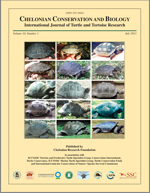BioOne.org will be down briefly for maintenance on 14 May 2025 between 18:00-22:00 Pacific Time US. We apologize for any inconvenience.
PROLOGUE (1)
Research Articles (12)
TURTLE POETRY (1)

No abstract available
Effects of Rainfall and the Potential Influence of Climate Change on Two Congeneric Tortoise Species
Evaluating Noninvasive Methods of Sex Identification in Green Sea Turtle (Chelonia mydas) Hatchlings
No abstract available
